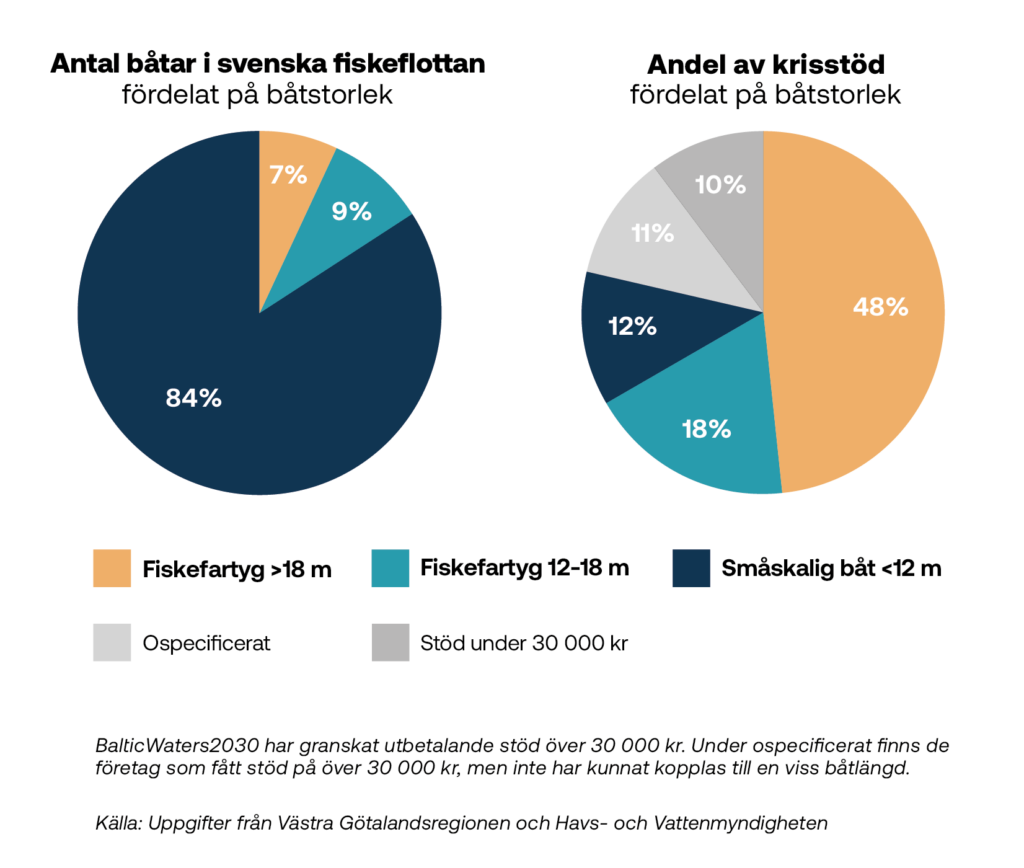Last year, the government decided on a special aid programme for commercial fisheries of SEK 40 million to cover increased fuel costs as a result of the rise in diesel prices. In its application to the EU, Sweden writes that the aid is intended to ensure continued operations for professional fishermen and that the situation particularly affects small-scale fishing in the Baltic Sea, which currently lacks the margins to handle increased operating costs. Despite this, the aid was distributed mainly to large-scale fisheries, while small-scale fisheries were only allocated a fraction.
“Interruption or reduction of production can lead to long-term negative consequences, including decommissioning, for small-scale coastal fisheries,” Sweden writes. Despite this, the aid was designed to particularly favour large-scale fisheries, which are often already profitable.
Today, coastal fisheries in the Baltic Sea are finding it difficult to catch fish due to declining stocks and heavy forage fishing that depletes larger individuals in the herring stocks. Coastal fishing is having to increase its efforts to find catches, and may therefore be particularly affected by increased fuel costs. The crisis has contributed to a quarter of small-scale fishing boats – over 100 of them – stopping fishing in the Baltic Sea between 2021 and 2022.
However, the government support was not based on fuel costs, but on the sale of catches. This means that those coastal fishermen who have difficulty obtaining catches, and currently lack the margins to cope with increased costs, are disadvantaged. In addition, the fish had to be sold fresh, which excluded many coastal fishermen who process their fish themselves and led them not to apply for the aid.
The larger vessels have also received a higher share of money, 10.1 per cent of their sold catch, while the smaller ones instead received between 6 and 7.6 per cent of the value of their sold catch. For active gears – pelagic trawls and bottom trawls – fishermen also received a higher share of the sales value, compared to fishermen using more gentle and environmentally friendly passive gears.
| Length in metres | Equipment segment | Aid as a percentage of the value of the landed catch |
| >17,99 | Aktive | 10,1 |
| 12–17,99 | Aktive | 7,7 |
| 00–11,99 | Aktive | 7,6 |
| >12 | Passive | 6,7 |
| 10–12 | Passive | 6,0 |
| 00–9,99 | Passive | 6,9 |
In dialogue with BalticWaters, the responsible ministry has said that the aid has been designed to promote food supply in Sweden. For herring and sprat fishing in the Baltic Sea, however, this has meant that coastal fishing for food has been disadvantaged, while large-scale fishing for feed has received a higher proportion of support.
Although SEK 40 million was set aside for the aid, not all the funds have been utilised, which leads the Ministry to assess that there have been neither obstacles nor aggravating circumstances for small-scale coastal fishing to take advantage of the aid. BalticWaters does not share the Ministry’s assessment. In the light of how the aid has been designed and paid out, it can be concluded that large-scale fishing has been favoured. Coastal fishermen state that the design of the aid has affected interest in applying for it.
BalticWaters has requested and analysed aid payments of over 30,000 SEK, which confirms that the aid has mainly gone to large-scale fisheries.

Image: Antal båtar i svenska fiskeflottan fördelat på båtstorlek = Number of boats in the Swedish fishing fleet by boat size, Andel av krisstöd fördelat på båtstorlek = Share of emergency aid by boat size, Fiskefartyg = Fishing vessel, Småskalig båt = Small-scale vessel, Ospecificerat = Unspecified, Stöd under 30 000 kr = Aid under 30 000 SEK
Balticwaters har granskat utbetalande stöd över 30 000 kr. Under ospecificerat finns de företag som fått stöd på över 30 000 kr, men inte har kunnat kopplas till en viss banlängd = Balticwaters has examined aid payments of more than SEK 30,000. Under unspecified are the companies that have received aid of more than SEK 30,000 but have not been able to be linked to a specific length.
Source: Data from Region Västra Götaland and the Swedish Agency for Marine and Water Management.


